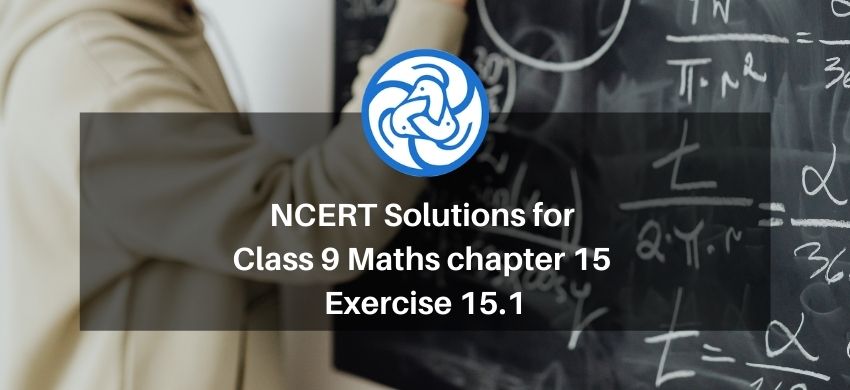
Hey, are you a class 9 Student and Looking for Ways to Download NCERT Solutions for Class 9 Maths chapter 15 Exercise 15.1? If Yes then you are at the right place.
Here we have listed Class 9 maths chapter 15 exercise 15.1 solutions in PDF that is prepared by Kota’s top IITian’s Faculties by keeping Simplicity in mind.
If you want to score high in your class 9 Maths Exam then it is very important for you to have a good knowledge of all the important topics, so to learn and practice those topics you can use eSaral NCERT Solutions.
In this article, we have listed NCERT Solutions for Class 9 Maths chapter 15 Exercise 15.1 that you can download to start your preparations anytime.
So, without wasting more time Let’s start.Download The PDF of NCERT Solutions for Class 9 Maths chapter 15 Exercise 15.1 "Probability"
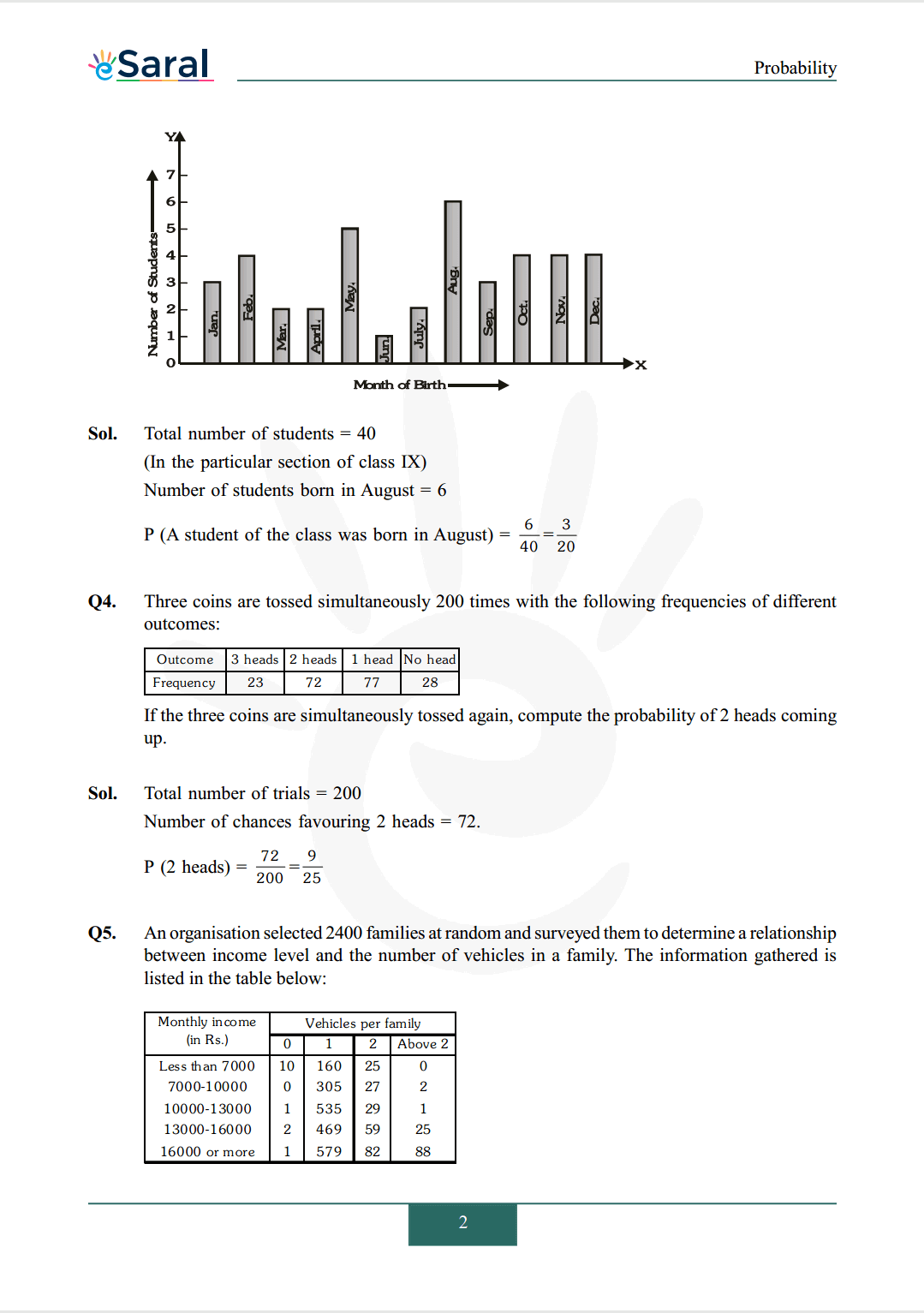
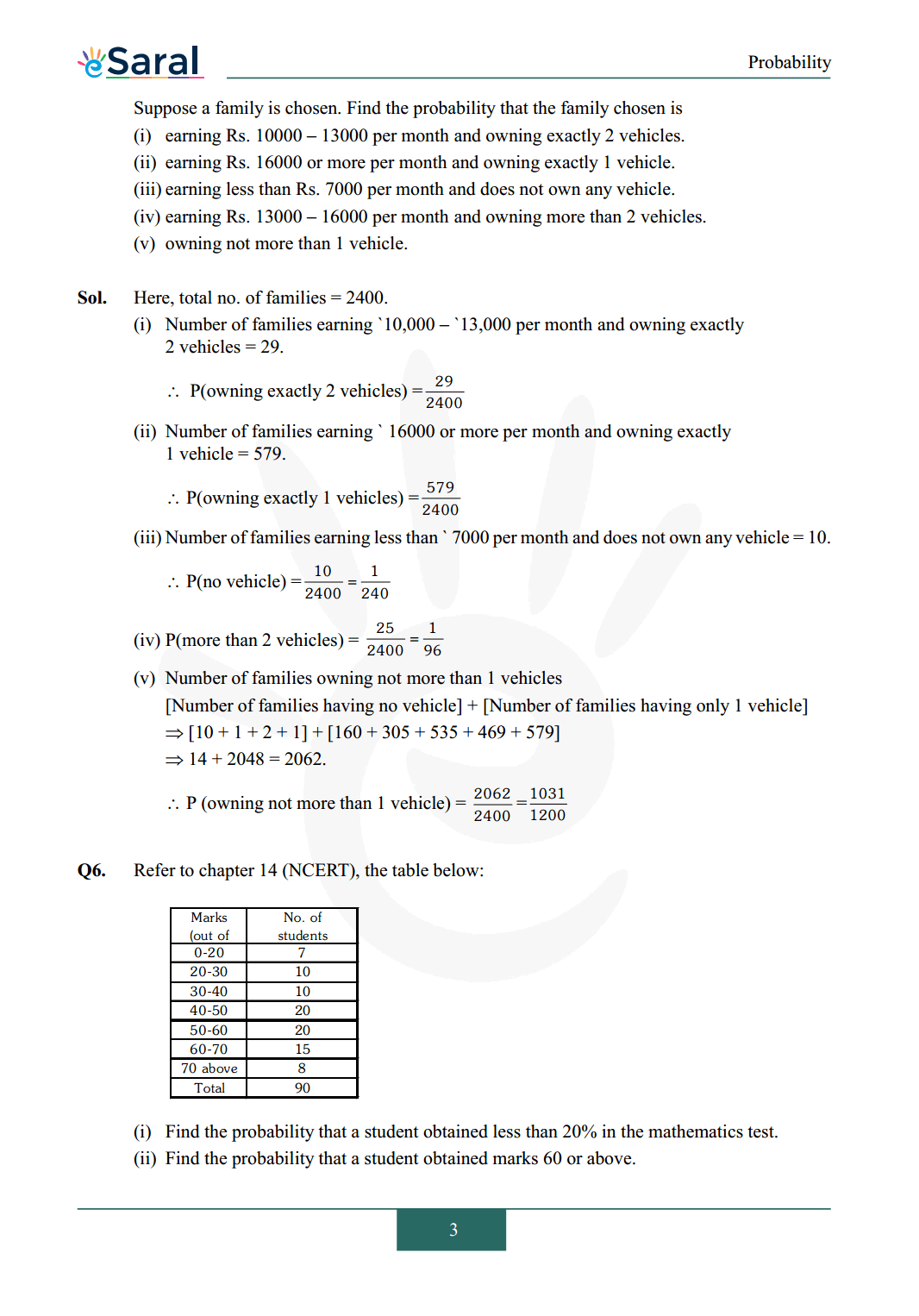
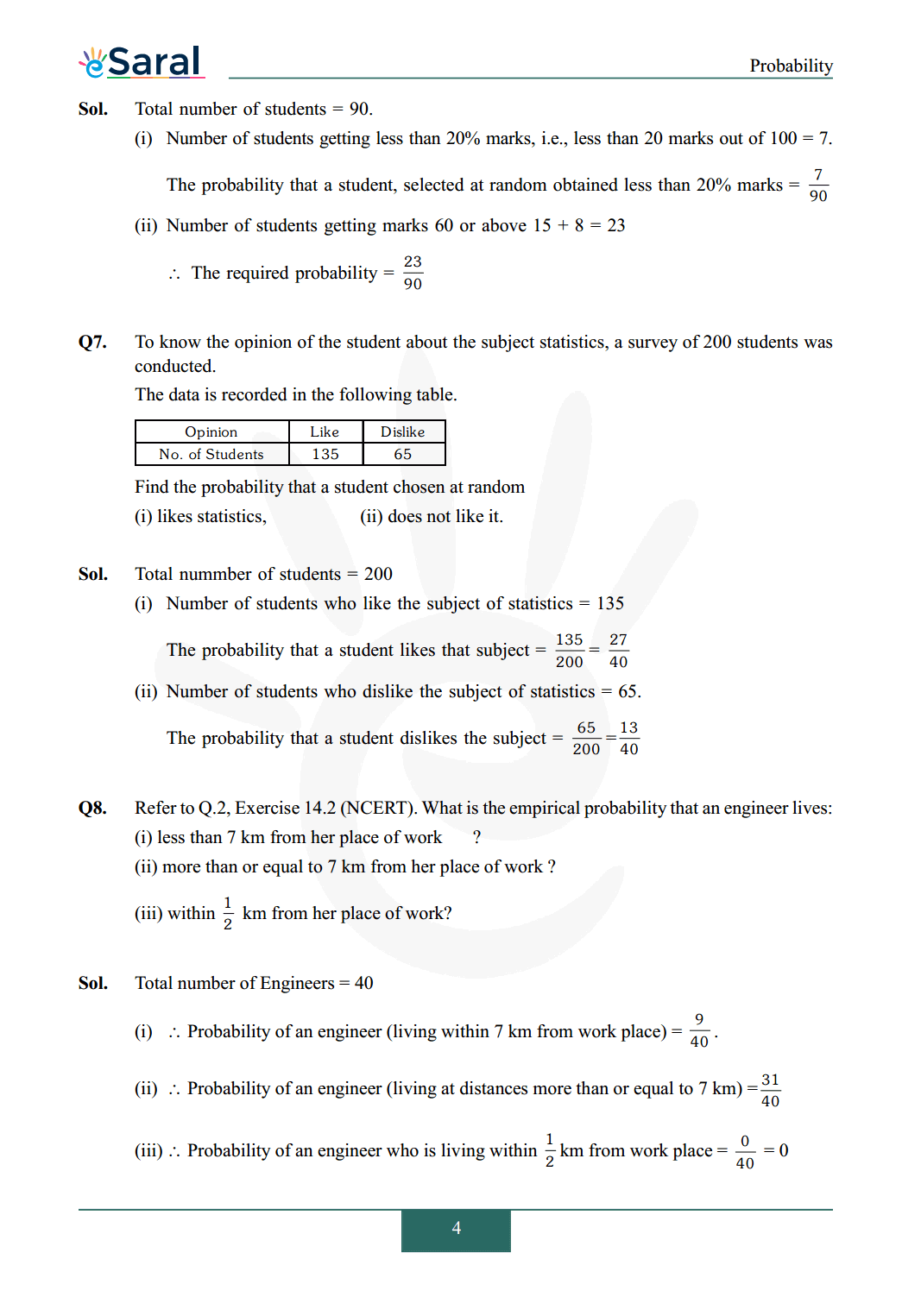
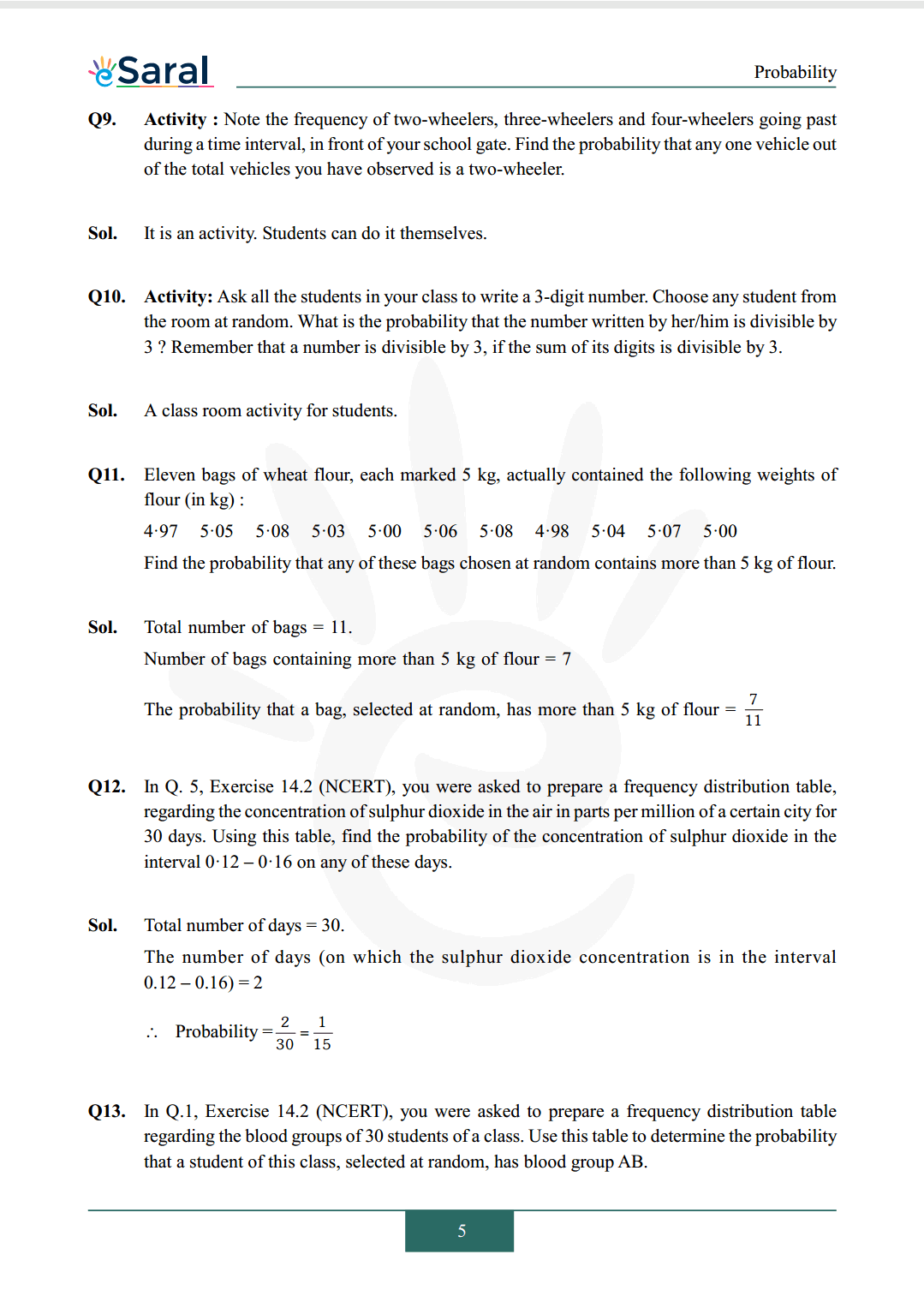
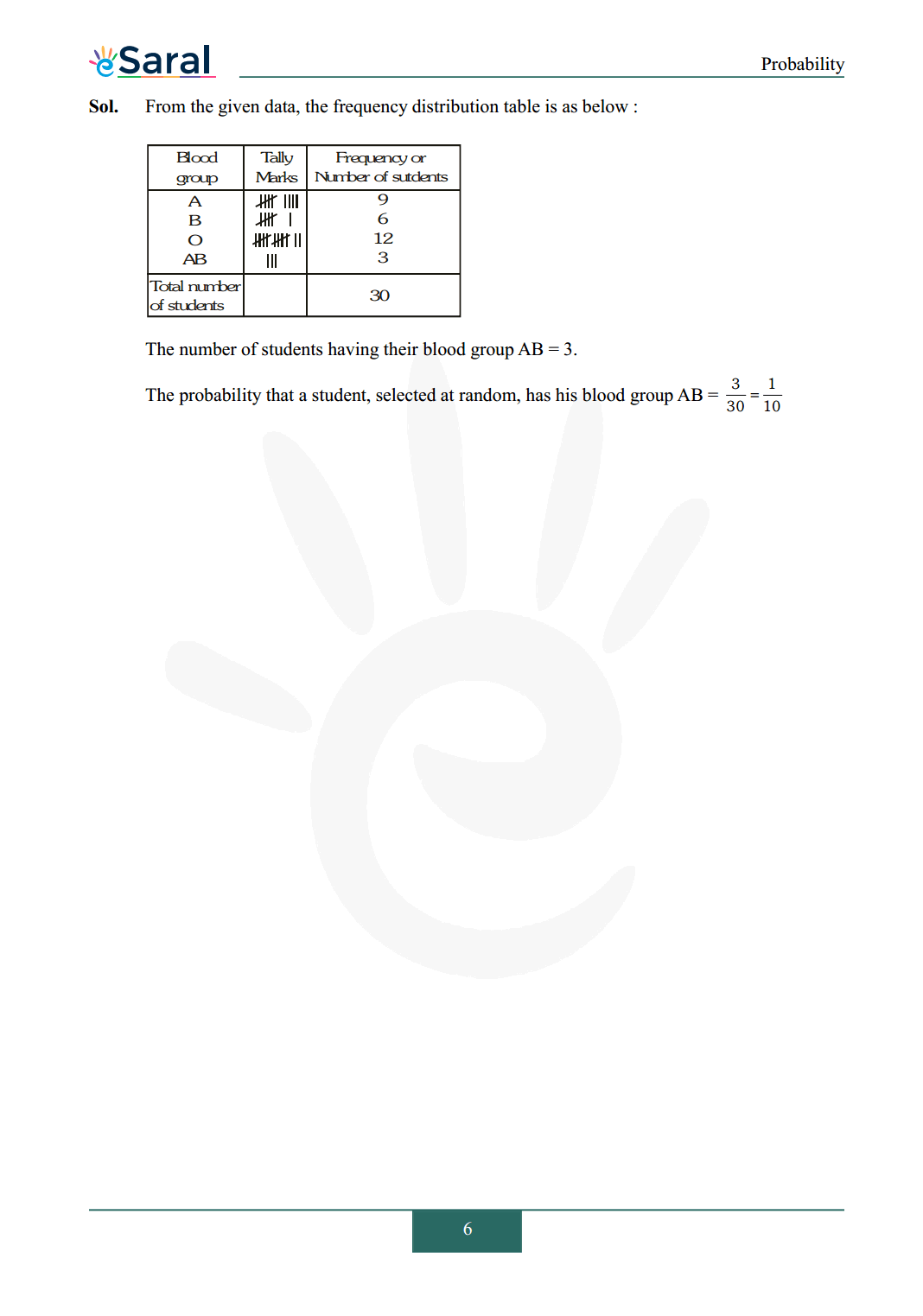
So, that’s all from this article. I hope you enjoyed this post. If you found this article helpful then please share it with other students.
Q1. In a cricket match, a batswoman hits a boundary 6 times out of 30 balls she plays. Find the probability that she did not hit a boundary.
Q2. 1500 families with 2 children were selected randomly, and the following data were recorded:

Compute the probability of a family, chosen at random, having (i) 2 girls (ii) 1 girl (iii) No girl Also check whether the sum of these probabilities is 1.
Q3. Refer to Example 5, Section 14.4, Chapter 14 of NCERT. Find the probability that a student of the class was born in August. The statement of the data in the example is stated as below : In a particular section of class IX, 40 students were asked about the months of their birth and the following graph was prepared to represent the data:
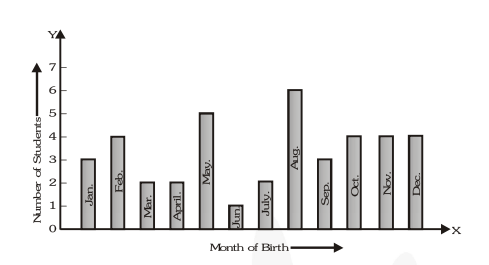
Q4. Three coins are tossed simultaneously 200 times with the following frequencies of different outcomes:

If the three coins are simultaneously tossed again, compute the probability of 2 heads coming up.
Q5. An organization selected 2400 families at random and surveyed them to determine a relationship between income level and the number of vehicles in a family. The information gathered is listed in the table below:
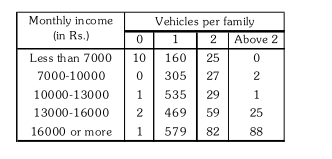
Suppose a family is chosen. Find the probability that the family chosen is
(i) earning Rs. 10000 – 13000 per month and owning exactly 2 vehicles.
(ii) earning Rs. 16000 or more per month and owning exactly 1 vehicle.
(iii) earning less than Rs. 7000 per month and does not own any vehicle.
(iv) earning Rs. 13000 – 16000 per month and owning more than 2 vehicles.
(v) owning not more than 1 vehicle.
Q6. Refer to chapter 14 (NCERT), the table below:
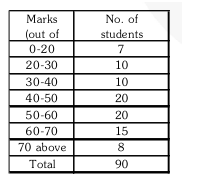
(i) Find the probability that a student obtained less than 20% in the mathematics test.
(ii) Find the probability that a student obtained marks 60 or above.
Q7. To know the opinion of the student about the subject statistics, a survey of 200 students was conducted.
The data is recorded in the following table.

Find the probability that a student chosen at random
(i) likes statistics,
(ii) does not like it.
Q8. Refer to Q.2, Exercise $14.2$ (NCERT). What is the empirical probability that an engineer life?
(i) less than $7 \mathrm{~km} $ from her place of work?
(ii) more than or equal to $7 \mathrm{~km} $ from her place of work?
(iii) within $\frac {1}{2} \mathrm{~km} $ from her place of work?
Q9. Activity: Note the frequency of two-wheelers, three-wheelers and four-wheelers going past during a time, interval, in front of your school gate. Find the probability that any one vehicle out of the total vehicles you have observed is a two-wheeler.
Q10. Activity: Ask all the students in your class to write a 3-digit number. Choose any student from the room at random. What is the probability that the number written by her/him is divisible by 3? Remember that a number is divisible by 3, if the sum of its digits is divisible by 3.
Q11. Eleven bags of wheat flour, each marked $5 \mathrm{~kg} $, actually contained the following weights of flour (in kg):
$\begin{array}{ccccccccccc}4 \cdot 97 & 5 \cdot 05 & 5 \cdot 08 & 5 \cdot 03 & 5 \cdot 00 & 5 \cdot 06 & 5 \cdot 08 & 4 \cdot 98 & 5 \cdot 04 & 5 \cdot 07 & 5 \cdot 00\end{array}$
Find the probability that any of these bags chosen at random contains more than $5 \mathrm{~kg}$ of flour.
Q12. In Q. 5, Exercise $14.2$ (NCERT), you were asked to prepare a frequency distribution table, regarding the concentration of sulphur dioxide in the air in parts per million of a certain city for 30 days. Using this table, find the probability of the concentration of sulphur dioxide in the interval $0 \cdot 12-0 \cdot 16$ on any of these days.
Q13. In Q.1, Exercise $14.2$ (NCERT), you were asked to prepare a frequency distribution table regarding the blood groups of 30 students of a class. Use this table to determine the probability that a student of this class, selected at random, has blood group $\mathrm{AB}$.
Also Read,
Download NCERT Class 9 Maths Book PDF
Download NCERT Class 9 Maths Exemplar PDF
Download Complete Solutions for Class 9 Maths chapter 15 PDF
Download Class 9 Maths Chapter 14 Exercise 14.1 Solutions PDF
Download Class 9 Maths Chapter 14 Exercise 14.2 Solutions PDF
Download Class 9 Maths Chapter 14 Exercise 14.3 Solutions PDF
Download Class 9 Maths Chapter 14 Exercise 14.4 Solutions PDF
If you have any Confusion related to NCERT Solutions for Class 9 Maths chapter 15 Exercise 15.1 then feel free to ask in the comments section down below.
To watch Free Learning Videos on Class 9 by Kota’s top Faculties Install the eSaral App
Here we have listed Class 9 maths chapter 15 exercise 15.1 solutions in PDF that is prepared by Kota’s top IITian’s Faculties by keeping Simplicity in mind.
If you want to score high in your class 9 Maths Exam then it is very important for you to have a good knowledge of all the important topics, so to learn and practice those topics you can use eSaral NCERT Solutions.
In this article, we have listed NCERT Solutions for Class 9 Maths chapter 15 Exercise 15.1 that you can download to start your preparations anytime.
So, without wasting more time Let’s start.
Download The PDF of NCERT Solutions for Class 9 Maths chapter 15 Exercise 15.1 "Probability"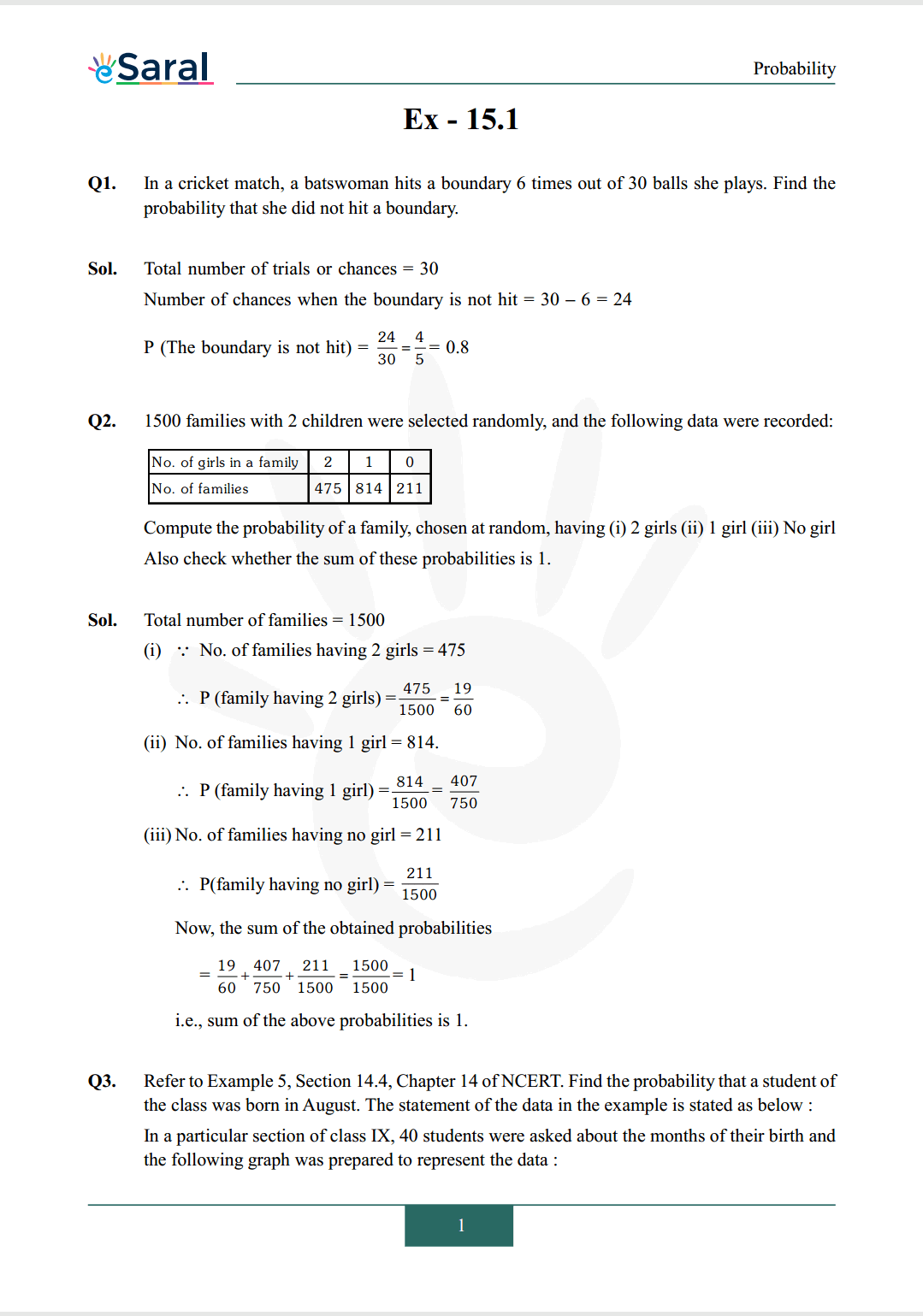





So, that’s all from this article. I hope you enjoyed this post. If you found this article helpful then please share it with other students.
All Questions of Chapter 15 Exercise 15.1
Once you complete the chapter 15 then you can revise Ex. 15.1 by solving following questions
Q1. In a cricket match, a batswoman hits a boundary 6 times out of 30 balls she plays. Find the probability that she did not hit a boundary.
Q2. 1500 families with 2 children were selected randomly, and the following data were recorded:

Compute the probability of a family, chosen at random, having (i) 2 girls (ii) 1 girl (iii) No girl Also check whether the sum of these probabilities is 1.
Q3. Refer to Example 5, Section 14.4, Chapter 14 of NCERT. Find the probability that a student of the class was born in August. The statement of the data in the example is stated as below : In a particular section of class IX, 40 students were asked about the months of their birth and the following graph was prepared to represent the data:

Q4. Three coins are tossed simultaneously 200 times with the following frequencies of different outcomes:

If the three coins are simultaneously tossed again, compute the probability of 2 heads coming up.
Q5. An organization selected 2400 families at random and surveyed them to determine a relationship between income level and the number of vehicles in a family. The information gathered is listed in the table below:

Suppose a family is chosen. Find the probability that the family chosen is
(i) earning Rs. 10000 – 13000 per month and owning exactly 2 vehicles.
(ii) earning Rs. 16000 or more per month and owning exactly 1 vehicle.
(iii) earning less than Rs. 7000 per month and does not own any vehicle.
(iv) earning Rs. 13000 – 16000 per month and owning more than 2 vehicles.
(v) owning not more than 1 vehicle.
Q6. Refer to chapter 14 (NCERT), the table below:

(i) Find the probability that a student obtained less than 20% in the mathematics test.
(ii) Find the probability that a student obtained marks 60 or above.
Q7. To know the opinion of the student about the subject statistics, a survey of 200 students was conducted.
The data is recorded in the following table.

Find the probability that a student chosen at random
(i) likes statistics,
(ii) does not like it.
Q8. Refer to Q.2, Exercise $14.2$ (NCERT). What is the empirical probability that an engineer life?
(i) less than $7 \mathrm{~km} $ from her place of work?
(ii) more than or equal to $7 \mathrm{~km} $ from her place of work?
(iii) within $\frac {1}{2} \mathrm{~km} $ from her place of work?
Q9. Activity: Note the frequency of two-wheelers, three-wheelers and four-wheelers going past during a time, interval, in front of your school gate. Find the probability that any one vehicle out of the total vehicles you have observed is a two-wheeler.
Q10. Activity: Ask all the students in your class to write a 3-digit number. Choose any student from the room at random. What is the probability that the number written by her/him is divisible by 3? Remember that a number is divisible by 3, if the sum of its digits is divisible by 3.
Q11. Eleven bags of wheat flour, each marked $5 \mathrm{~kg} $, actually contained the following weights of flour (in kg):
$\begin{array}{ccccccccccc}4 \cdot 97 & 5 \cdot 05 & 5 \cdot 08 & 5 \cdot 03 & 5 \cdot 00 & 5 \cdot 06 & 5 \cdot 08 & 4 \cdot 98 & 5 \cdot 04 & 5 \cdot 07 & 5 \cdot 00\end{array}$
Find the probability that any of these bags chosen at random contains more than $5 \mathrm{~kg}$ of flour.
Q12. In Q. 5, Exercise $14.2$ (NCERT), you were asked to prepare a frequency distribution table, regarding the concentration of sulphur dioxide in the air in parts per million of a certain city for 30 days. Using this table, find the probability of the concentration of sulphur dioxide in the interval $0 \cdot 12-0 \cdot 16$ on any of these days.
Q13. In Q.1, Exercise $14.2$ (NCERT), you were asked to prepare a frequency distribution table regarding the blood groups of 30 students of a class. Use this table to determine the probability that a student of this class, selected at random, has blood group $\mathrm{AB}$.
Also Read,
Download NCERT Class 9 Maths Book PDF
Download NCERT Class 9 Maths Exemplar PDF
Download Complete Solutions for Class 9 Maths chapter 15 PDF
Download Class 9 Maths Chapter 14 Exercise 14.1 Solutions PDF
Download Class 9 Maths Chapter 14 Exercise 14.2 Solutions PDF
Download Class 9 Maths Chapter 14 Exercise 14.3 Solutions PDF
Download Class 9 Maths Chapter 14 Exercise 14.4 Solutions PDF
If you have any Confusion related to NCERT Solutions for Class 9 Maths chapter 15 Exercise 15.1 then feel free to ask in the comments section down below.
To watch Free Learning Videos on Class 9 by Kota’s top Faculties Install the eSaral App
